Roman Ruins
One of the most impressive Roman ruins I have seen to date is the one at Brescia. I don't know why this should be the case as we have been to the colloseum in Verona, the Arena in Pula and many smaller sites over the past several years. There is something about the columns standing out against the sky that makes this one especially memorable. True they are patched and repaired, true there are some parts of the building that are more repair than roman yet they create the right effect.
Brescia has always been an important center of trade on the Roman road. It was the first main stop for repair and refueling when traveling North from Rome. As a result, many industries sprang up to accommodate the need of the travelers. It has remained an industrial hub ever since. Today it is known for its metallurgy; tools, machines, and of course mechanical and automotive engineering. Having resisted the celts it was peacefully engulfed by the Roman empire.
Throughout history, Brescia has shown itself to be a surprisingly independent city. The citizens managed to recover themselves after being sacked and overthrown by the Goths, Visigoths, Huns, Byzantines, Lombards, French, and Austrians. From 855 to 875 it became the capital of the Holy Roman Empire until it's citizens again freed themselves of that burden. In 1859 the city became part of the Kingdom of Italy, yet they even then received a gold medal for resisting Fascism during world war II. They are known as the Lioness of Italy for their defeat of the Austrian rulers in 1849. This city, if it is known for nothing else ought at least to be remembered as a city which wishes to be left alone.
In the middle ages, Brescia along with both Cremona and Verona was influential in the creation and perfecting of the Violin. It is from this region that such famous brands as Stradivarius stem.
The ruins were discovered relatively recently while a section of the hill (now behind them) was being removed to accommodate a construction site.
Once a government center, they are now a very interesting museum, the entrance of which is actually subterrane. We were taken through the rooms one at a time in small groups. The doors were unlocked at intervals in order to allow the humidity in each room to stablize. Inside the mosaic floors and painted walls are being carefully maintained.
In the main building, to which the long flight of stairs leads, plaques and inscriptions from all over the city have been collected and hung. A palace of delights for the Latin enthusiast. This building is the Capitolium. A Roman Forum. Adjacent is an amphitheater.
Today the Capitolium is decorated by life size figures carved out of pumice stone. They are fascinating in their uniqueness and their simplicity.
I would love to have one for my livingroom. That being somewhat difficult to manage I have decided to paint one. The half-finished canvas stands at the moment on my easel waiting for me to once again pick up the brush, touching up layers and adding the thousands of little holes pumice is known for. Maybe tomorrow...
I had not expected the City to hold so many treasures. It is definitely a place I would like to go back to again.
To get posts as soon as they are published click on the subscribe button at the top of the page or Follow by clicking on the follow button.




























Comments
Post a Comment